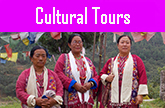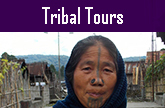Eastern Arunachal Tribal Tour
Tour Duration : 6 Nights / 7 Days
Travel Season : September to May
eastern arunachal tribal tour itinerary
Day 01: Arrive Dibrugarh
Meet upon arrival at Dibrugarh airport and take transfer to hotel.
Dibrugarh:
The ‘Tea City of India’, Dibrugarh is located in the eastern part of Assam. It is situated on the banks of the river Brahmaputra in upper Assam. Main attraction is mainly tea gardens along with oil and natural gas reserves. The foothills region of Dibrugarh is composed of lateritic soils, which is suitable for the production of tea plants. Besides, Dibrugarh city is the main educational centre of Upper Assam with important educational institutions like Dibrugarh University, Assam Medical College, Kanoi College, Salt Brook Academy etc.
Arrive Dibrugarh and check-in hotel. In the afternoon, if time permits, visit -
Jokai Botanical Garden:
Jokai Botanical Garden cum Germ-plasm Center, located in Jokai Reserve forest covers an area of 12 hectares. Recognized as one of the remaining rain forest situated in North Eastern provinces, it showcases rich floral bio-diversity of the region. The botanical garden has a stock room where germplasm (a collection of genetic resources for an organism) of some vulnerable floral species are collected. Jokai Reserved Forest is a protected bio-diversity tropical rain forest to which migratory birds flock from different parts of the world every year.
En route - Have a glimpse of Mancotta Tea Garden to observe the tea plantation. Observe the teams of colorfully dressed tea garden female workers plucking the delicate buds and leaves with their nimble fingers.
Haaj-Paar:
It is a small weaving centre located at Chiring Chapori, an urban locality of Dibrugarh. Here traditional mekhela chadars are woven in variety of designs by employed women and is run privately. They also weave sarees from both ‘muga’ and ‘paat’ silk unique to Assam. The products made in the centre are available for sale.
Overnight: Stay in hotel.
Day 02: Dibrugarh - Namphake Village - Dibrugarh (55 kms one way, 1 hr 20 mins drive)
In the morning after early breakfast, take transfer to Namphake Village.
Namphake Village:
The Phakial community of Assam established Namphake village in 1850 AD. Presently, the village is inhabited by 600 members of the community. The word ‘Phake’, connected with Tai community, is a combination of two Tai words ie, ‘Pha’ and ‘ke’ meaning ‘wall’ and ‘ancient’ respectively. Historically, natives in Myanmar dwelling near ancient stone walls were recognized as ‘kunphake’ meaning “people inhabiting near phake part of the country”. The present inhabitants of Namphake village are considered to be the descendants of those ‘phake’ people of Myanmar. The Tai race, a large section of nomadic Mongolian association, currently inhabits in entire Asia. In Myanmar, Thailand and Yunnan province of China, they are recognized as the Shan, Siamese and Pai respectively. In countries like Cambodia, Laos and Vietnam, they are familiar as the Lao population. Tai Phake people in Assam are popularly known as ‘Phakial’. Many noted historians of Assam opine that the Phakials are immediate descendants of the mighty Ahoms. Phakial people established some other villages like Borphake, Tipamphake in the districts located in upper Assam. Yet the largest village among all is the Namphake village near Naharkatiya. In spite of being fused into greater Assamese culture, the Phakial community has been conserving its own distinctive culture and age old traditions and thereby contributing to the rich Assamese culture. Followers of Buddhism, the Phakials in Namphake village are maintaining a Buddhist monastery with several astounding monuments within its premises. Moreover, a Buddhist Pagoda and a symbolic Ashoka pillar in the monastery premises are worth seeing.
Later, return to Dibrugarh. Visit a Sonowal Kachari Village like Hatimora, Bogpara, Chaulkhowa, Niz Mankotta, Tepor Gaon, Boiragimath.
Sonowal Kachari village:
Designated to be the scheduled Bodo tribal community, Sonowal Kacharis form the third largest tribal group (plains) of Assam. They are primarily found in the districts of Dibrugarh, Tinsukia, Jorhat, Golaghat, Sivasagar, Lakhimpur and Dhemaji. It has been very difficult to trace the origin of Sonowal Kacharis over the years. It is popularly believed that a few population of the Kachari tribal community were occupied in cleaning gold elements from the sands of river during the reign of the Ahom rulers. Thus, the prefix 'Sonowal' meaning ‘gold washer’ was added before their main tribal identity ‘kachari’ to indicate their particular population. A famous anecdote recommends that during the rule of Ahom king Godadhar Singha, a 'Gossian' (meaning a priest) named 'Kechaideo' had mystical powers of contributimg a definite quantity of gold in a bamboo tube. After becoming followers of 'Kechaideo', these people became popular as Sonowal Kacharis.
Sonowal Kacharis have 7 exogamous clans namely Chiripuria, Balikhitiari, Ujani-Kuchiya, Amarabamiya, Tipamiya, Dhulial and Namoni-Kuchiya. Yet again, these clans are sub grouped into 14 sub-clans namely Muktal, Hagral, Borttajoal, Madan, Ahmal, Manikiyal, Dhekial, Formal, Oingial, Saru Hazowal,Dangral, Kumral, Chetial and Lothial. Sonowal Kacharis are dedicated followers of Vaishnavism. Some prominent songs of Sonowal Kacharis are Husori, Haidang, Biya naam, Aai naam, Gossain Naam, Dhai naam, Apeswara Naam and Lakhimi naam. Some amazing traditional dance forms in addition to Bihu are Bohuwa dance, Kula-burhir dance and Hugra dance.
The Sonowal Kacharis presently do not have any particular dialect of their own. They commonly speak Assamese language. During Ahom rule, the Sonowal Kacharis in their course of integration with the non tribal communities adopted non tribal surnames like Bora, Saikia, Hazarika etc. Agriculture and poultry farming of rearing hens, ducks & cattle are the major occupations of Sonowal Kacharis. Drinking of Rice Beer is a popular habit among masses. Weaving at traditional ordinary weaving machines at home to produce items like endi chadar (silk cloth) and gamocha is a customary activity among women.
Overnight: Stay in hotel.
Day 03: Dibrugarh - Roing (155 kms, 4 hrs drive)
In the morning after breakfast, take transfer to Roing. En-route cross - Brahmaputra River through Bhupen Hazarika Setu (Dhola-Sadiya Bridge), India's longest bridge above water which is 9.15 kms long.
Roing:
Set amidst lush green trees and snow-capped mountains, Roing lies on the bank of river Dibang at an altitude of 3000 feet. A district headquarter of Lower Dibang Valley, Roing is acclaimed to be the only town dominated by the Idu Mishimi and Adi tribes.
Arrive Roing and check-in traditional guest house. In the afternoon, visit –
Sally Lake:
Sally Lake is a natural lake resort surrounded by luxuriant green forest located at a serene atmosphere in the mountainous terrain of Mishimi hill. The picturesque view of the lake with different fish species seen in its clean water attracts the tourists of all age groups.
Nehru Van Udyan:
Nehru Van Udyan is renowned garden among visitors for sheltering a wide variety of precious species of orchids. An amazing view of the Deopani River flowing nearby from the Eje Breeze Tower, a house of diverse species of cactus and a beautiful garden in its site adds grandeur to the Nehru Van Udyan.
Chimri Fort or Rukmininati:
Rukmini Nati, also famous as Chimiri Fort, is believed to be a fort belonging to 14th -15th century. The remains of burnt and baked bricks representing rich civilization of that period reflect the richness of glorious legacy of the past.
In the evening, remain free at leisure to explore the beauty of surrounding nature by your own.
Overnight: Stay in guest house.
Day 04: Roing - Mayudiya Pass - Roing (56 kms one way, 1 hr 30 mins drive)
In the morning after breakfast, take transfer to Mayudiya. Enjoy guided bird watching on the way.
En-route cross - Sikang River through Dibang River Bridge (Sikang River Bridge), India's second longest bridge above water which is 6.2 kms long.
Mayudiya:
Mayudiya, situated at an altitude of 8700 feet above sea level, is a tourists’ hotspot nestled in snow-capped mountains, picturesque valley and green breath-taking landscapes. This magnificent hill resort receives snowfall every year from December to March adding exquisite beauty by covering the area with thick carpets of snow. Mayudiya serves as a gateway to the Indo-China border. It is an ideal holiday destination for adventure seekers, trekkers and bird watchers across the planet since various endangered avifauna species are recorded here including Tragopan.
In the afternoon, visit -
Idu Mishmi village:
The Idu Mishmi is a principal sub-tribe of Mishmi tribal community. They belong to mongoloid stock. Typical hairstyle, distinctive costumes and artistic designs embedded on their clothes differentiate Idu Mishmi people from other tribes of the state. The unique dialect of Idu Mishmis is a branch of the Tibeto-Burman group of languages. Idu Mishmis are animist by tradition. They worship Nani-Intaya as the creator of the universe. Idu Mishmis worship both generous and malicious spirits. Some serious people still support deep-rooted aesthetic values in their daily life with pride and respect. Sine-Ru, a mythological figure and the first Idu Mishmi priest, is worshiped with honour and admiration by the tribe. The print of his palm on the rocks at Athu Popu near Keyala Pass on China border is still regarded as supreme and sacred. The Idu people are by nature. Idu women are very good weavers. Their craftsmanship is showcased in the designs created on handloom clothes. The Idu Mishmi men are expert craftsman in producing eye-catching bamboo and cane baskets. The main festivals of Idu Mishmis are Reh and Ke-meh-ha. Reh festival, celebrated in February, is an occasion for the community to take part in dance, feast, drink and relax.
Afternoon, return to Roing.
Overnight: Stay in hotel.
Day 05: Roing - Tezu (62 kms, 1 hr drive)
In the morning after breakfast, depart for Tezu. En route visit -
Bhismaknagar:
Later, arrive at Tezu and check in tourist lodge.
Tezu:
Tezu, district headquarter of Lohit district of Arunachal Pradesh, is a small picturesque town inhabited by many ancient tribes like Mishmi, Digaru, Khamti and Miju tribal community. The legacy of Mishmi tribe still continues with their King and Queens dwelling in Tezu. Mishmi tribe holds rich culture and traditions dating back to the age of great epic Mahabharata in which Lord Krishna's first queen Rukmini is introduced as a Mishmi damsel. Tezu is also colonized by a small population of Tibetan refugees of 1960s staying in Lama Camps. They maintain their unique customs and traditions. Mishmi people worship their main deity, Lord Ringyajabmalu. Tamladu festival, observed on Makar Sankranti ie, 15th January every year, is a grand celebration among the Mishmi tribe.
Overnight: Stay in tourist lodge.
Day 06: Tezu - Dibrugarh (250 kms, 5 hrs 30 mins drive)
In the morning after breakfast, take transfer to Dibrugarh. En route visit -
Parasuram Kunda:
Parasuram Kunda, an acclaimed place of pilgrimage among Hindus, is situated in the bank of the river Lohit from Tezu. The origin of the Parasuram Kunda is connected with Parasuram's matricide. According to a famous tale of great epic Mahabharata, Parasuram, one incarnation of Lord Bishnu, was the obedient son of saint Jamadagni and Renuka. One day, while returning from bath in the River Ganga and bringing water from the holy river for midday worship, Renuka was too late to cause anger in saint husband. Jamadagni asked all of his six sons to kill Renuka. Only Parasuram obliged to cut off his mother Renuka’s head to fulfill the desire of his father. But consequently, for being indulged in such a severe crime, the handle of his axe got stuck to his right hand. Jamadagni was exceptionally satisfied with Parasuram for sincerely obeying his order and asked him to have a boon. Parasuram prayed to his father Jamadagni to bring back his mother Ranuka alive and inquired how to get relieve the soul after committing the sin of matricide. Jamadagni approved his son’s boon and Renuka got her earthly life back. Further, he ordered Parasuram to have a holy bath in "Brahma Kunda" to rinse the sin. Later, the place was renamed as Parasuram Kunda. Devotees across India visit this place on day of “Makar Sakranti” ie, 14th January every year.
Chongkham:
Chongkham, literally meaning as ‘Place of gold’ in Khampti language, is the main center of Khampti culture in entire hilly terrain of Arunachal Pradesh.
In Chongkham, visit -
Khampti village:
Khamti tribe is a sub-group of the Shan tribe found in Myanmar, Lohit district of Arunachal Pradesh and some parts of Assam. The original name of the tribe is spelled as ‘Hkamti’ which is later called by the Assamese as ‘Khampti’. As per census report prepared in 2000, the total population of Khamti people around the world is a meager figure of 13,100 out of which 4,235 exist in Myanmar. Khamtis are offspring of some migrants who arrived at this region during 18th C from the mountainous terrain of Irrawaddy. Khamti tribe reflects East Asian facial appearance. They are sincere devotees of Theravada Buddhism. Tai-Khampti accepted ‘Lik-Tai’ language, a script of Shan origin. Their mother tongue is popularly recognized as Khamti language.
World Peace Pagoda:
World Peace Pagoda situated in a river-island is an ultimate place for meditation. Large Buddha statues located in central part of the vihar add magnificence to the site.
Khamti Raja's Chong:
In Khamti language, chong means Buddha-Vihar. Constructed in Thai-architectural style, Khamti Raja's Chong at Guna nagar is acclaimed for remnants of Gautama Buddha.
Later, depart to Dibrugarh.
Arrive at Dibrugarh and check in hotel.
Overnight: Stay in hotel.
Day 07: Dibrugarh departure
In the morning after breakfast, take transfer to Dibrugarh Airport / Railway Station for your onward destination.
Tour terminates here
North East India Tourism
Package Inclusions:
# All ground transportation by a comfortable vehicle driven by dedicated driver
Package Exclusions:
# Any air fare or train fare


















